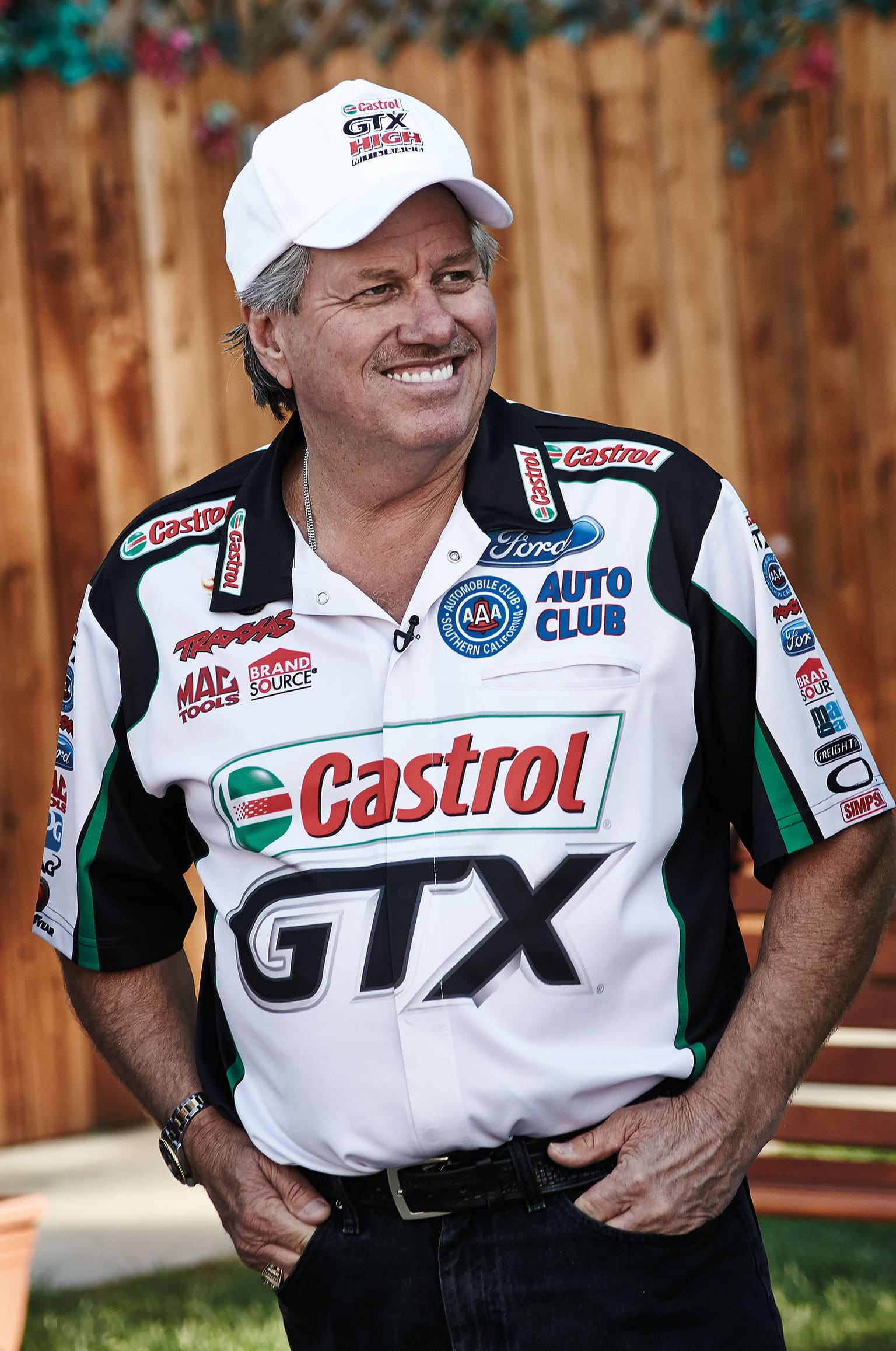And what an engine! Following the familiar philosophy of the traditional American stock-block, it is nothing more exotic than a pushrod two-valve V8. But it is all-aluminium, displacing just under 8.2 litres to stay within the NHRA [National Hot Rod Association] limit of 500 cubic inches. Sitting within the vee is an immense supercharger, and above that a fuel injection system supplying a mix of nitro-methane and alcohol under high pressure. Horsepower? Although some claim even higher figures, the normally accepted output is 8000bhp. Yes, that’s eight thousand – more than all the cars on the front five rows of a Formula 1 grid put together.
Even if you find that hard to digest, you have to believe the times, and the speeds. After some well publicised fatal accidents, and with terminal speeds climbing higher and higher, the NHRA reduced the length of drag race courses for the fastest classes by 320 feet, from the traditional quarter-mile to 1000 feet. But in that distance a Top Fueller or a Funny Car can go from a standing start to more than 300mph – in less than four seconds. Zero to 100mph has been calculated to occupy 0.8sec. The driver’s body will, for a split second, sustain up to 8g: 4g under acceleration, and then 4g the other way when he deploys the double parachutes to slow the car at the end of the course.
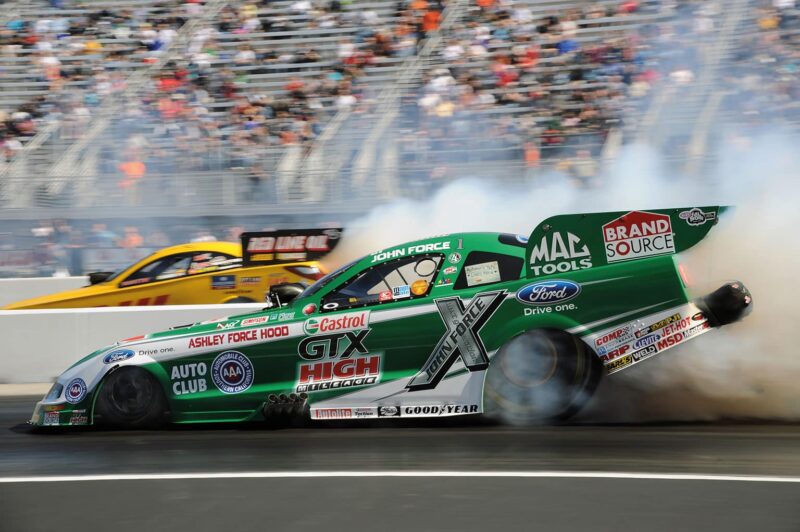
Can you feel the Force? An American hero captured in action across five decades
Conspicuous consumption isn’t a worry here. A single run, including starting and warming up the engine, burn-out (spinning the wheels to heat the tyres), staging (bringing the car into position on the start line) and then racing for 1000 feet, will use up about 23 gallons of nitro-alcohol mix – say about 0.01mpg. And that single run will represent the total life of most of the engine’s moving parts. Between each run, therefore, a team of eight mechanics will totally strip and rebuild the engine, replacing pistons, rods, bearings, valves and plugs. Depending on schedule they can do that in 40 minutes, and they might have to do it four times a day, during which time their car will run flat out for a total of less than one mile. A final statistic: a dragster engine at full noise creates 150 decibels, enough to cause severe pain and permanent ear damage. When two Top Fuellers or Funny Cars leave the start line side by side, anyone standing within 100 yards will feel the ground shake.
So the world of drag racing is pretty unusual, populated by some pretty unusual people, and I decided it was time to persuade a big figure from that world to sit down to lunch. While Top Fuel cars are fractionally faster than Funny Cars, it is the Funny Cars that tend to be the stars of the show. And the star of the Funny Car show, for the past 20 years or more, has been a larger-than-life Californian called John Force.
Born on the wrong side of the tracks, he used to sleep in his truck when he couldn’t afford rent. He ducked and dived from deal to deal until finally his fast talk, more than his fast times, garnered him some sponsorship and his cars began to get better. Now a gravelly-voiced, unstoppably loquacious 64-year-old, he has been NHRA Funny Car Champion an astonishing 16 times in 24 seasons. And he’s winning still.
But John Force Racing isn’t just about an individual: it’s a whole family. John’s three daughters Ashley, Brittany and Courtney are all drag racers. Ashley was Funny Car Rookie of the Year in 2007, beating her father to score an outright win at Atlanta. She is now married to JFR staffer Daniel Hood, and since starting a family has hung up her helmet. Courtney began drag racing at 17, and was 2009 champion in Top Alcohol – those are non-nitro rails that develop a mere 3500bhp and post sub-6sec runs. Then she moved up to Funny Car, and was 2012 Rookie of the Year. Her boyfriend is Indycar racer Graham Rahal, son of Bobby.
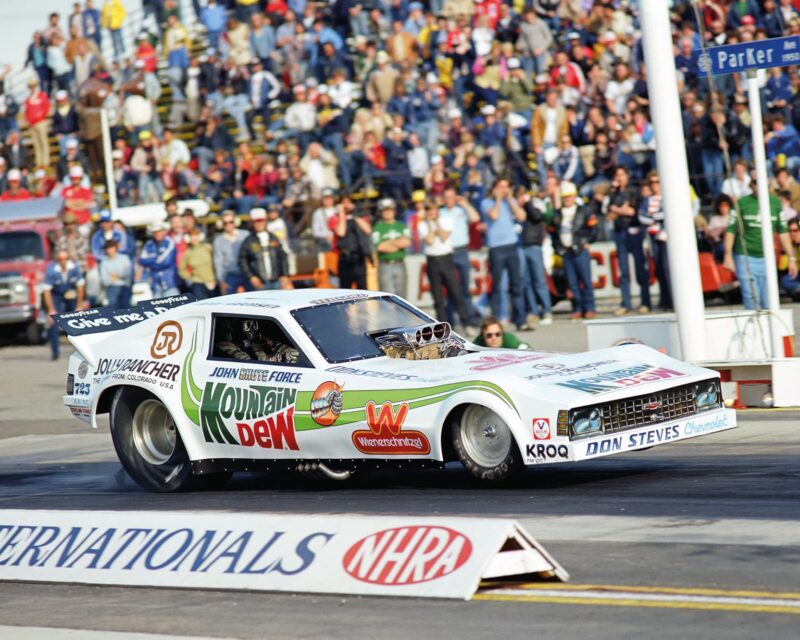
Rudimentary clothing and a slight absence of torsional rigidity in 1982
Meanwhile Brittany decided to buck the family trend and become a teacher. But she started drag racing anyway, and while studying at university she moved into the unblown Super Comp class. Having taken her degree she turned professional and, in 2013, she turned to the most extreme cars, the Top Fuel dragsters. She too won Rookie of the Year, and her best so far is a 3.78sec run with a terminal speed of 324mph. That makes her the fastest Force of all. John’s daughter by his first marriage, Adria, is the team’s chief financial officer and is married to Team Force racer Robert Hight, who beat John to the Funny Car title in 2009.
The whole clan has become even better known across the USA as the subject of an American TV reality show, Driving Force, which depicted the highs and lows of this extraordinary family with its extrovert, volatile father, three glamorous young daughters and long-suffering mother Laurie. It ran for two series until the death of Team Force driver Eric Medlen made the wrong sort of headlines in 2007, and nervous TV execs pulled it from the schedules. Now it is returning, and John suggested I take lunch with him on the Hollywood set during gaps between filming.
I’ve enjoyed these Lunch With… features in a variety of unusual locations around the world, but this had to be the strangest. At Universal Studios, next to the make-believe suburban house that provides the exterior and interior for the programme, is a dusty street of weathered wooden buildings that down the years has been the scene of countless cowboy movies. Sitting outside the pseudo frontage of a 19th century western saloon, snacking on film-set catering, somehow seemed an entirely appropriate place to learn more about the world of drag racing.
John’s beginnings weren’t easy. As a child he contracted polio, which left him with one leg shorter than the other. His father was an itinerant truck driver, his mother a Native American short-order cook. During the strawberry season they would pick in the fields, having tied toddler John to a tree so he wouldn’t wander off. “We lived on bologna sandwiches without the bologna, just the mustard. That’s still my favourite food today. When I got to school and tried to play football
I couldn’t run too well, but realised that if I couldn’t catch them I could at least run into them. I used to bullshit even then: I told the other kids my dad drove the elephant truck for Barnum & Bailey’s Circus, when in fact he just hauled logs and hay.
“At 16 I somehow got myself an old wreck of a Chevy, cracked windshield, little six-cylinder engine. I took the mufflers off to make it sound good. I lived and slept in that car, schoolbooks on the back seat, copy of Playboy magazine under the front seat. I’d hang out at Harvey’s Broiler, the big drive-in that featured in the movie American Graffiti. You’d get 1000 cars there on a Saturday night. I became a truck driver like my dad, got married at 19, had a baby at 20. But all I wanted to do was race.”
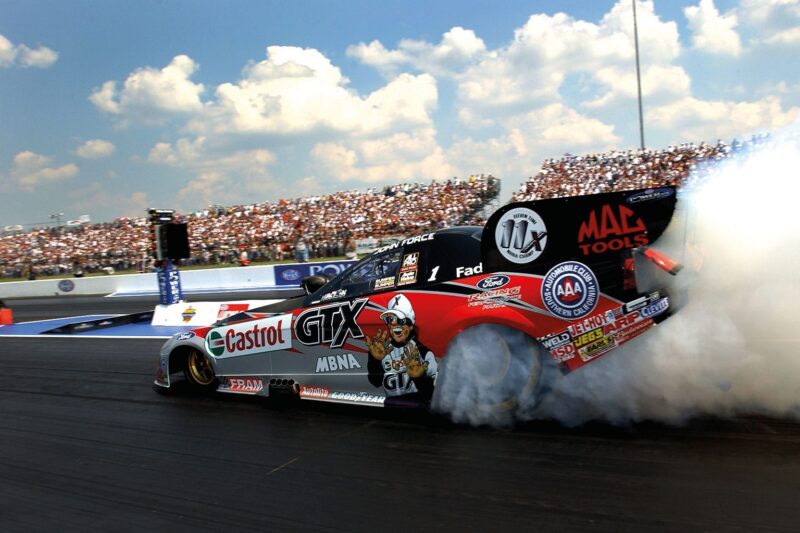
Lighting up Indianapolis Raceway Park in 2002
Bob Harmeyer
He took a succession of tired bangers to the strip, “held together with baler twine and tank tape,” and then lucked into another racer’s cast-off Oldsmobile that he got for $150.
“I bought a block that had been blown, it was full of holes we welded up. But the cheque I wrote to buy it bounced, and they came looking for me. They said, ‘You think that block’s got holes in it, there’ll be more holes in you if you don’t cover that cheque’. More than once I’ve spent the night in a tree in our backyard with a shotgun across my knees, because I owed somebody and I thought they’d come after me.”
In the early days John’s driving skills didn’t impress anyone, either. One NHRA official said, “We tried to ban him because we were afraid he’d kill himself. He hit everything but the tower.” But when an Australian promoter wanted to put together a group of American drag racers to entertain the Oz crowds, and two established stars dropped out at the last minute, John talked his way in. He had never been on a plane before, never been out of California.
“We turned up wearing cowboy hats and boots, talking big, but I didn’t even have a proper licence. The first run I did my engine exploded, kicked all the rods out through the block, big fire. The crowds loved it. Sorted that somehow, but other things kept breaking, and most times I didn’t get to the end of the strip. In the end the promoter said, ‘You’re the worst racer I’ve ever seen. I’m not paying you. For all I care, you can swim back to America’.”
John has many more lurid stories about his earlier efforts to make it as a drag racer, but in the end, with hustle following hustle, he managed to find a few sponsors. One of his first was hamburger chain Wendy’s. “I painted the car up with their logos to make it look like a big deal, but just about all we got was free burgers and a bit of appearance money at different Wendy’s outlets. I wasn’t too proud to shave my legs, take the car to a Wendy’s, put on a dress and a red wig with pigtails, and pose with the Wendy’s girls.” His race shop was just the forecourt of his local gas station and his cars weren’t well prepared. Some promoters didn’t want to accept his entries because of his reputation as a leaker – someone who strewed oil and engine parts over the track.
But he never, ever gave up on his dream. Somehow he found enough deals, scrounged enough money and begged enough favours to keep going. He was always a showman in and out of the car, doing more lurid burnouts than anyone else, and always talking big into the nearest TV camera or microphone.
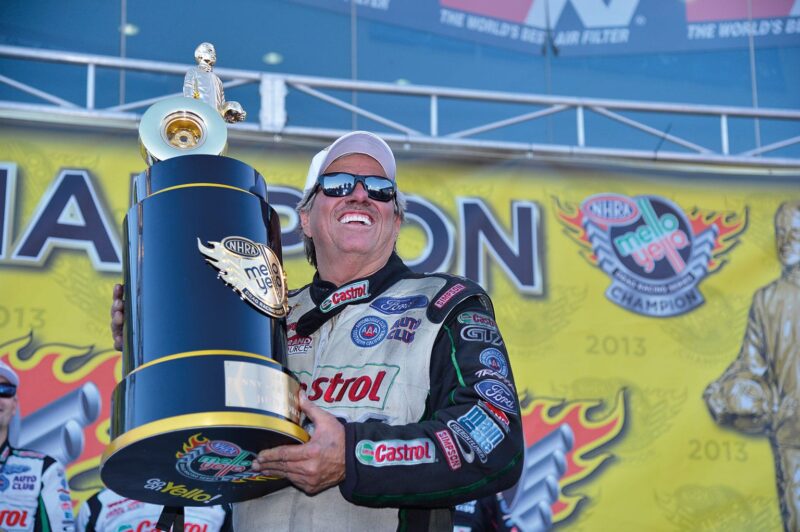
Cradling his most recent title trophy, October 2013
But he realised that to find greater success than just being the top talker he needed a crew chief that could help him raise his game. He found that man in Austin Coil: calm, quietly spoken, as different from Force as he could be.
“Coil had already built championship-winning cars, so I went up to him in the paddock – he was sitting in the back of his truck eating his lunch – and I said straight out, ‘I want to hire you’. He looked at me and said, ‘Why would I ever want to work for you?’ I said, ‘Because I got a million bucks’. I didn’t, of course. Anyway, I promised Coil I’d give him a million if he won me the championship, and Coil said he’d win me the championship if I promised him a million. At the end of that season neither of us could deliver. But we kept at it. It took us five years. He got the car right and also taught me how to drive a dragster, how to use the car properly. In the end we won 15 championships together. The man is a genius. And his loyalty was amazing: during the winter, when I had no money to pay the wages, he’d give me back his salary so I could make sure the guys didn’t leave.”
Coil came on board for the 1986 season, but it was a while before the results started to come, helped by a new sponsorship deal with Castrol that began at $5000, grew to be a major part of Force racing’s budget and was still going 28 seasons later. In 1990, still chasing his first title, he scored seven back-to-back wins: then at Brainerd during Saturday’s runs a massive engine blow-up sent him to hospital with burns and left the car a smoking ruin. On Sunday morning, bandaged up and in fresh overalls, Force was back. The crew had somehow rebuilt the car overnight around a new engine, and he won a crucial victory that took him on to that maiden championship. “That was when I knew we’d put together the best team in the business.”
Over the next 13 seasons Force won the Funny Car title 12 more times, only slipping to second place in 1992. That was the year he had a big accident at Memphis. “I’ve always been a big Elvis fan. One of my cars is in the museum at Graceland, and Priscilla Presley gave me an Elvis TCB [Takin’ Care of Business] ring. Well, that time at Memphis I had a big one. The engine exploded, we went on fire, blew the body off, what was left of the car hit the wall at 280mph and disappeared way off into the dirt. Everybody was sure I was dead. Up come the fire truck and the ambulance, with the TV guys chasing them, and as I crawl out of the wreck on my hands and knees I see the TV cameras and the first thing I say is, ‘I saw Elvis!’ Well, you know, lots of people claim Elvis sightings, and because everyone said I’d come back from near-death that went all over. But I have to tell ya, I didn’t really see Elvis. I made that up.
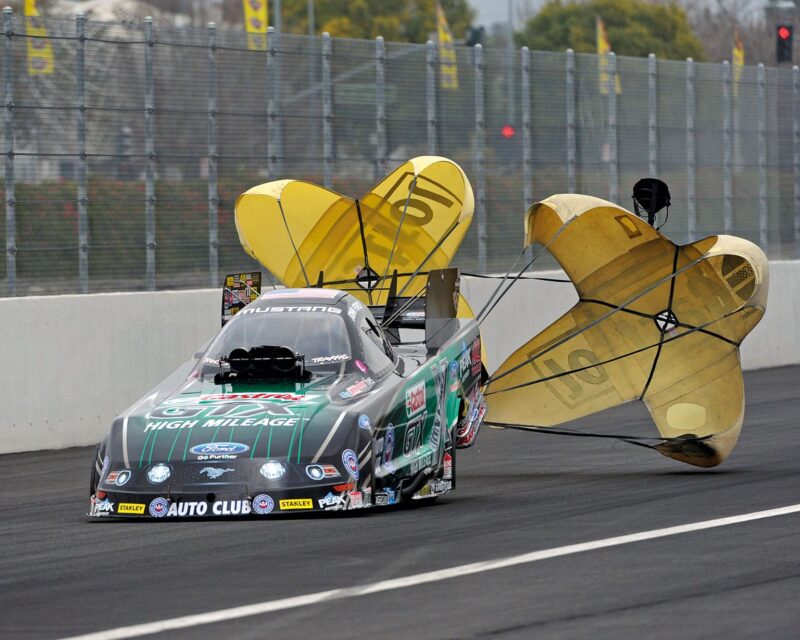
Getting it stopped after this year’s record run in Pomona
AutoImagery
“After that a promoter at a strip up in New England had the idea to fly me into the track in a little Cessna in a coffin, so I could get out of the coffin dressed as Elvis with a wig and all, but in my racing overalls. Then the guy flying the plane nearly flew into the power cables running across the track. I was thinking about Buddy Holly and Ritchie Valens and The Big Bopper [musicians who died together in a notorious light plane crash in 1959]. I was wondering who they’d get to play me in the movie of my life. That was the life we led, do anything for the crowds and for the dollars. And I loved every minute of it.”
Inevitably, as with any class of motor sport, there were disputes and accusations. Traction control is outlawed in drag racing, but in 1994, as Force had his fourth title in his sights, a long-running battle on and off the track between Force and fellow Funny Car racer Al Hofmann came to the boil. Hofmann relished his image as a scowling rough-tongued redneck who never missed an opportunity to bad-mouth Force which of course the promoters loved. But it got serious when Hofmann accused Force of hiding a traction control device somewhere on his car. The scrutineers tore down Force’s car countless times but nothing was found, whereupon Hofmann claimed that Force must be wearing it hidden under his fire suit. “When he said that, I stripped down right there on the track in front of everybody, showing my truck driver’s belly and my saggy old man’s underpants. And I was younger then. The pictures went everywhere, and my wife said, ‘If you ever embarrass me like that again, you’ll be in worse trouble than you got with Hofmann’.
“It was hard for Laurie. In the early days, when the girls were little, I was always on the road, I was never home. She says we called them Ashley, Brittany and Courtney – A, B, C in age order – so I could remember which was which. Either I’d come home all happy because I’d won, so I’d take the kids to Disneyland and they’d miss school. Or I’d come home drinking too much because I’d lost, be on the phone screaming and swearing at the team and knocking holes in the walls. In the end she’d had enough. She packed my bags and threw me out. Later on, when Ashley first started racing, she said to her mom, ‘Now I know why Dad’s crazy. It’s the gut-ache of losing, it’s the high of winning. You ought to give him another chance’. That was when Laurie took me back, and we’ve been together ever since. She has more patience than Mother Teresa.”
Into the new century the times continued to come down, the speeds continued to rise and the titles continued to pile up. John Force Racing expanded to two and then three cars, with Tony Pedregon and Gary Densham driving, and Pedregon won the 2003 title when John hit a run of mechanical problems. When Pedregon left Eric Medlen, one of the JFR team and son of the No2 car crew chief, stepped up to drive. In 2007, during a test session at Gainesville, a tyre deflated on Medlen’s car and it developed a massive shake. “It was a very high-speed harmonic oscillation that can happen when the tyre bounces the car about 18 inches up and down repeatedly at 300mph. The HANS device was mandatory by then, but still Eric’s helmet was banged against the roll cage from side to side at high frequency and he sustained severe brain injuries from the battering. He never recovered, and we lost him four days later.

Early days with Corvette-shaped challenger, 1979
AutoImagery
“That started us on a major safety programme. We missed the next round while we figured out what wasn’t right with these cars. We looked at everything. We altered the seat belts and the head restraints, and we redesigned the padding on the roll-cage, so that however many times the driver’s helmet hits it, the padding will stand up to it.” Then six months later at Dallas, after suffering a cut tyre, Force’s car veered across into Kenny Bernstein’s racing alongside and broke in half. “The front half, engine, front tyres, all that just kept on going. I stayed in the back half. I’d popped the parachutes and by the grace of God it didn’t roll, the chutes slowed it and then when it settled down it just flopped over onto its side. I was OK, just had some leg injuries.” In fact he needed six hours of reconstructive surgery, eventually spending a month in hospital.
He joked that it was the nearest he’d had to a vacation in 35 years.
“The typical dragster chassis hadn’t changed much over three decades. It was just a place to put the motor and hang the tyres. After that we did a lot of work. Ford’s development people helped us, and we even got the military involved. We now make our own chassis, of stronger chrome-moly tubing, and we moved away from heat-treating it. We call it the Eric Medlen chassis.
“We had some other ideas, too. Like Funny Car drivers were getting burned because the fire was filling the body inside and you couldn’t breathe from the smoke, even with on-board extinguisher systems and fire blankets around the engine. So we came up with a system operated by a button that allowed you to eject the body completely. But NHRA outlawed it, because at high speed it sent the body way up in the air, and they didn’t want it ending up in the stands and hurting spectators.”
Austin Coil retired at the end of the 2010 season, after 24 seasons as John’s crew chief. Mike Neff, who had gone from wrench to driver and back to wrench, was promoted to crew chief for 2013. John’s 2013 Funny Car title was his 16th as a driver and his 18th as an owner, because in 2009 son-in-law Robert Hight had added to Tony Pedregon’s 2003 win. And John started 2014 still winning. He took victory in the opening round, the Winternationals at Pomona, with a 3.965sec run at 323.58mph – an all-time Funny Car record.
Now we’re joined outside the western saloon by Brittany Force, who out of her race suit, helmet and face mask is slim, very attractive and totally feminine. I ask her to take me, an ignorant Limey, through the procedure of going down the strip from a standing start to over 320mph in less than four seconds. The first point to understand is that the winner of each duel is the driver who gets to the finish line first, but the published ET (elapsed time) is measured from when the car starts to move. So a slower ET can still win a race if the other driver’s reaction time has been worse.
“Yes, races are won and lost by reaction time. We call the starting lights the Christmas tree. It’s a vertical column with staging lights, three amber lights, then a green and a red. The time between the stage lights and the amber lights coming on is random, but the time between the amber and the green, 0.4sec, doesn’t vary. If you wait until the green and then go, you’ll be done for. So you go on the amber. By the time you have reacted it will be green. But if you go too soon, you trigger the red light and you’re disqualified. I have a little portable tree I take around with me for practice.
“When you’re sitting waiting for the lights to change it feels like forever. My foot will be just resting on the throttle pedal, and I’m holding the car on the brake lever. There is no gearshift, and you have a six-disc centrifugal clutch that feeds the power to the tyres. So when I want to go, I just throw everything at the throttle. You don’t need to think about the brake lever: that’s torn right out of your hand when you tread on the throttle. Our cars run pretty straight, but if you get more grip one side than the other, or if it starts to shake, you need to steer quite a lot.
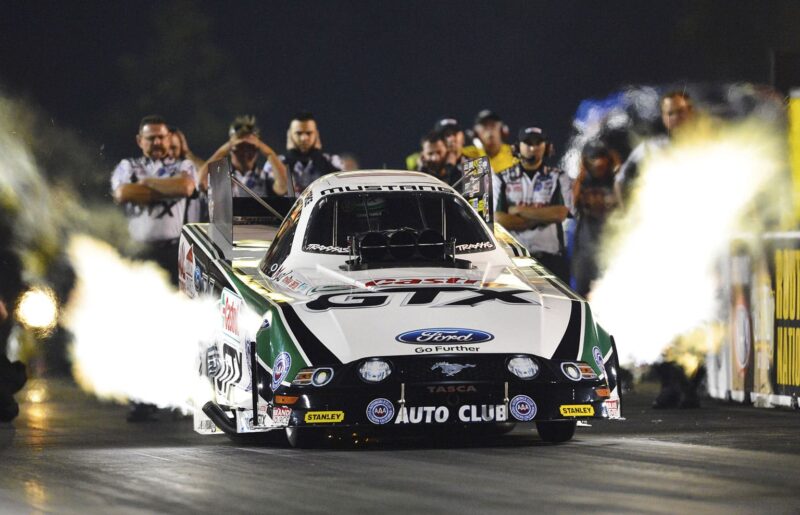
Force en route to title number 16 last year
At some tracks, if there’s a cross-wind blowing, it can be screened from the first part of the track by the bleacher stands. Then, after you pass the bleachers, the cross-wind can hit you and you really feel that. If you get out of the groove [the line of rubber progressively laid by repeated runs down the strip] you can go all over the place, which of course means you’re slower.
“At 1000ft there’s a big yellow line and orange flags, or amber lights if you’re racing at a night-time event. You pull your foot out of the throttle, push forward the big handle that sets off your parachutes, shut off your fuel and pull on the brake. So there’s plenty to do. The whole run has lasted less than four seconds, and when everything goes right it’s hard to analyse because it all happens so fast. But when something goes wrong everything seems to slow right down, because you have to think about what’s going on, you have to make some decisions about what to do, and then it seems to be happening in slow motion. It’s really weird. I’ve blown a few engines, but in Top Fuel that happens behind you, you just feel rather than hear this big boom, and the tug of it, because as the acceleration stops you are thrown forward against your belts. Blow an engine in a Funny Car and it’s all happening in front, it’s inside the car with you.
“People ask me whether turning professional in drag racing with John Force as my father has brought its own special pressures and problems. I don’t see it that way. No one’s ever going to fill his shoes. I have my own goals and what I want to achieve, and I hope to make him proud of me. It was only last season that I felt I was getting a proper grip on it all, and learning how to listen to the car.
“As for going into Top Fuel, John Force Racing had always been about Funny Car, and I wanted to do something different. My sisters and I grew up with drag racing all around us, packing our bags every weekend to go and watch Dad race, living on the road. His crew were like older brothers to us, and everyone in drag racing is like a second family anyway. Then Ashley got into the Super Comp class and started to work up, and I realised it was something that I could do, too. But when I was in Super Comp, if you’d told me I’d be driving in Top Fuel one day I’d have said, ‘No way. No way you’ll get me in one of those things’. Then I thought, ‘Try anything once’. And as soon as I tested a Top Fuel car I was hooked.
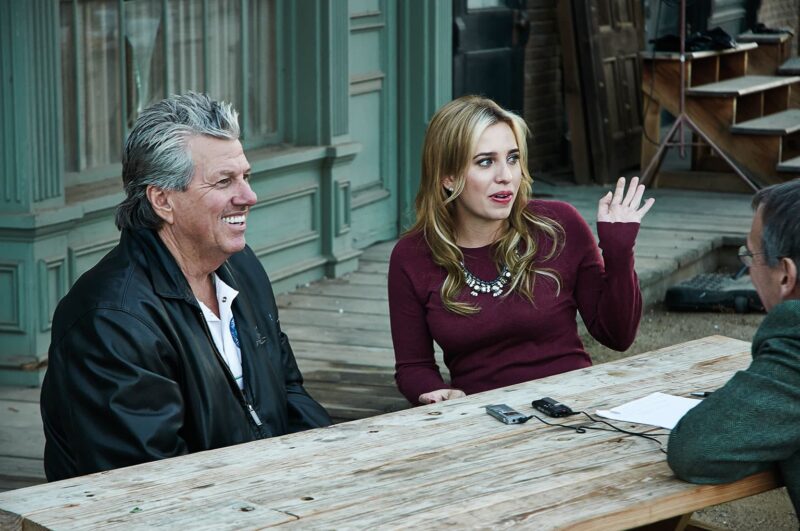
Brittany Force alongside her father
“When I was in Super Comp I had a crash in Las Vegas, hit the wall. That would have been at 250mph plus. I think it was a mix of the crosswind hitting me as I passed the end of the bleachers, and my own inexperience. The thing that scared me was that I had concussion. In hospital the doctors were asking me all these questions and I didn’t know where I was, couldn’t say how old I was or what I’d been doing. I still don’t remember the accident itself. But when I got myself back together I knew that if I didn’t get straight back on it I never would. So I ran the next day, and after one run I was perfectly fine.”
I’ve already heard more than enough to realise that racing dragsters at a professional level is extremely hazardous. So how does John feel about watching his daughters?
“I have to wear three hats. As a parent I don’t want any of them ever to get hurt, any more than their mom does. Then as a team chief, if one of them is in a crash, I want to get them back in the car right away, so they can go straight back to being quick. If you fall off a horse, you gotta get straight back on. And as a competitor – and I’ve come up against Ashley and Courtney a few times, and been beaten by them too, they’re my kids, I love ’em, but I want to beat ’em.”
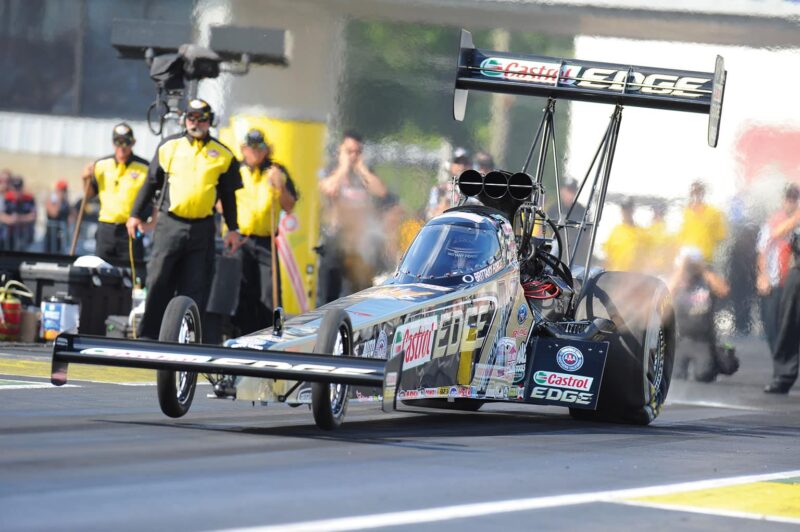
Brittany Force in top fuel action
From his humble beginnings as a leaker trying to stay one step ahead of his creditors, John Force has won a raft of awards, including in 1996 the Driver of the Year across all American motor sport – the first drag racer to receive that honour. He now employs 140 people at his race shop in Brownsburg, Indiana. Before each event a fleet of 18-wheel trucks rolls into the paddock to disgorge six Funny Cars, two Top Fuel cars and the parts and crew to run them: the Funny Cars for John, Robert and Courtney, the Top Fuel cars for Brittany. So, at 64 years old, with his daughters to carry on the Force legend, how long does John see himself continuing?
“I never want to stop. I’ve won 1,161 races, I’ve won 225 finals, but I don’t look at it that way. When you start to think you’re the best, when you think you’ve done it all, then where’s the motivation? My heroes are still Prudhomme and Garlits.” Don Prudhomme was the top Funny Car racer from the 1970s through to the 1990s. Don Garlits, known as ‘Big Daddy’, was the leading light in the sport from the 1950s until well into this century, and is thought of as the father of modern drag racing. “Plus, I have to tell you, I’m frightened of stopping, because I’m frightened it’ll all go away. I can’t relax, because if I do I might go back to being the kid with no money, sleeping in his car.”
Motor sport is a varied tapestry, from endurance racing to autocross, from rallying to karting, from Piaggio Apes on kart tracks to hill climbs and mud-plugging trials. None of those enjoy the advantages of F1’s television exposure, but every thread in the tapestry contributes to its richness and colour. And the thread of drag racing, with its over-the-top machinery and its over-the-top characters, makes its own unique contribution to the mix. At its lower levels, it can be a very cheap way to compete: in the USA there are more than 200 classes in the NHRA rule book, and you can drag-race virtually any two-wheeled or four-wheeled vehicle, including your daily driver. In Britain drag racing’s following is much smaller, but the sport is alive and well, with the Santa Pod and Shakespeare County strips running regular events.
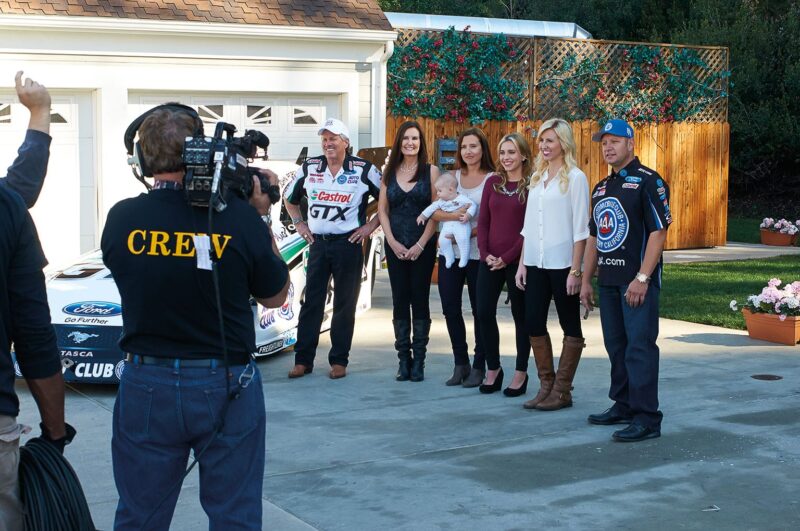
Drag racing’s first family: John, Laura, Ashley plus Noah, Brittany Courtney and Robert Hight
As for the big Stateside meets, they continue to make a gloriously spectacular show, and the crowds remain healthy when Indycar and even NASCAR have felt the cold wind of recession. A driver arriving in a coffin wearing an Elvis Presley wig might not be to everybody’s taste, but there are few motor sporting sights, or sounds, that can rival the 16,000bhp, 300mph thunder of a pair of Top Fuellers or Funny Cars duelling down the strip. As long as top-level drag racing continues to throw up larger-than-life characters like John Force and his remarkable family, it will surely thrive.
